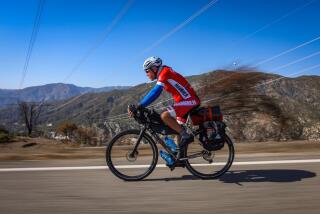Phil Southerland leads the pack in educating about cycling’s benefits for diabetics
- Share via
Reporting from Stateline, Nev. — When he was 10 years old, Phil Southerland figured out that riding his bike a little longer, pushing himself just a little further, allowed him to eat a candy bar or a piece of cake.
It was a wonderful revelation for a kid whose life was otherwise defined by numbers and calculations, by daily injections of insulin and constant monitoring of his physical chemistry.
When he got on his bike and just rode, Southerland earned two things: freedom and treats. Nothing is better for a boy, especially this boy.
When he was 7 months old, Southerland was found to have Type 1 diabetes, formerly known as juvenile diabetes. When the diagnosis was made, Southerland’s mother, Joanna, was told that her oldest son probably would be blind by the age of 25 and probably dead before he was 30.
Now 29 and fit, Southerland has defied one of the predictions and likes his chances of overcoming the other. His love for riding his bike developed into a passion for competitive cycling, and now he is the manager and cofounder of a team that races internationally and is on the roads this week competing in the Amgen Tour of California.
Its name: Team Type 1-Sanofi-Aventis — the first part, the disease that might have crippled him; the second part, the giant pharmaceutical company that is his main sponsor as well as a research partner.
Anyone who knew Southerland as a child might have seen this coming. Even as a boy, he learned to give himself insulin injections and came to understand that he was different — he could not eat or drink the things other kids did.
In cycling, he found an outlet for which he learned to control his disease while also using the sport as a tool to learn more about how exercise could improve the quality of his life.
“There was never any grand plan,” Southerland said. “It was all instinctive. I was a kid and I learned that with my cycling I could control my illness. It just happened. I rode the bike, I was better. I could do other stuff.”
That instinct led to the idea of being an entrepreneur and creating a cycling team devoted not only to winning races but also gaining knowledge of how exercise might help diabetics control their disease.
Southerland came up with this plan while he was competing at the University of Georgia.
“I was at a race and there was a guy from Auburn who I heard had diabetes,” Southerland said. “By that time I was really good at monitoring my blood sugar and knowing exactly how my body operated during competition.
“This kid didn’t know any of what I had learned. I found myself explaining what I knew and thinking there had to be a better way to do this.”
His solution was to take $400 he had and invest it in starting a cycling team that would allow himself and other diabetics an opportunity to compete at the sport’s highest levels — while at the same time providing scientists with the human guinea pigs they required to test diabetic equipment and study body chemistry issues.
Southerland sent letters to any company that made medicine or products for diabetics, passed out business cards to whoever would take one, and begged, cajoled and instructed anyone who would listen. He sold himself. He sold the sport. He sold the future.
Dennis Urbaniak, vice president of U.S. diabetes at Sanofi-Aventis, was an early buyer.
“Phil, with his personality and his enthusiasm and his optimism, helped make this a perfect fit,” Urbaniak said.
“What we’re doing is looking for examples that show you can live your life successfully with diabetes. One of the challenges when you’re diagnosed is being told all the things you can’t do. That is very intimidating. Phil’s an individual that took that information and pressed forward and has not only been successful but triumphant.”
That he’s done it in cycling is most ironic.
The sport has been rocked by doping allegations for more than a century, with riders using anything from arsenic, cocaine and caffeine to steroids and EPO and HGH to gain a competitive advantage.
At races, riders have been mocked by people dressed up as needles and syringes.
“I see the irony,” said Southerland, whose 20-rider team includes five diabetics who have special dispensation to use medicine during races. “Investigators search through the trash outside team hotels looking for needles and syringes and we have guys injecting themselves with insulin five times a day.”
This season, Southerland hired Dr. Juan Frias, an endocrinologist from San Diego, to conduct clinical research on the team’s riders, whether they are diabetic or nondiabetic.
One device the riders wear measures blood sugar. It is a square about the size of a cellphone and it needs to be stuck into the flesh.
“It got punched in, pushed around,” Team Type 1 cyclist Will Dugan said. “I was riding around and it was really bugging me. I thought, ‘Wow, that really hurts.’
“But then you think about what we’re trying to do and the research that’s being done and now it’s kind of cool.”
The team isn’t considered a contender to win the Tour of California, but Southerland hopes it might win a stage or two this week. And he is particularly optimistic about Javier Megias, a 27-year-old from Spain who he thinks could be a star.
Megias is a Type 1 diabetic, diagnosed when he was a teenager and already a promising cyclist.
Two years ago, Megias called Southerland. Megias had been riding for a Spanish-based team. With doping problems so prominent, Megias said he felt as if he were a criminal when he needed to take his medicine.
“They would ask me to do my injections behind a tree or in a bathroom so no one could see me,” Megias said of his old team. “It was a struggle for me a little bit. I knew about Phil’s team and I called. It has been a blessing.”
The next goal for Southerland, who quit competing about two years ago because of leg injuries not related to diabetes, is to get his team into the 2012 Tour de France.
“That’s my dream now,” Southerland said. “To see Team Type 1 jerseys on racers at the big race. And winning a stage. How about that? That’s something to hope for, isn’t it?”
twitter.com/mepucin
More to Read
Go beyond the scoreboard
Get the latest on L.A.'s teams in the daily Sports Report newsletter.
You may occasionally receive promotional content from the Los Angeles Times.










